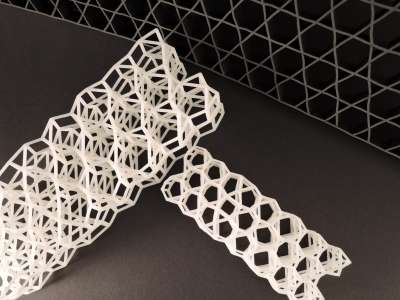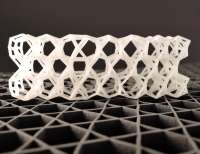Researchers design metamaterial that buckles selectively

Researchers from Leiden University, the Netherlands, have designed a novel metamaterial that buckles on demand. Small structural variations in the material single out regions that buckle selectively under external stress, whereas other regions remain unchanged. The research is published in this week's early edition of the Proceedings of the National Academy of Sciences.
Unconventional properties
The promise of metamaterials is to realize artificial structures with unusual properties that would be hard to come by in nature. Their unconventional properties can be programmed by suitable design of their geometry or topology. The Leiden researchers created a 3D-printed working prototype of a novel metamaterial that displays selective and tunable buckling.
Topological insulators as inspiration for new mechanical materials
The research was done in the Topological Mechanics Lab (Leiden), led by Vincenzo Vitelli. The lab is fully dedicated to studying the mechanical analogues of so-called "topological insulators," a recently discovered exotic quantum state of matter. When applied to macroscopic structures, the topological ideas underlying these exotic states give rise to materials with unusual mechanical properties.
Physical 'hunch'
'The design begins with a general idea, a physical 'hunch', based on this analogy,' explains co-author Jayson Paulose. 'The major strength of using these topological ideas in metamaterials design is that a topological material is guaranteed to have interesting behaviour at the boundaries.'
The next step is to predict the response of the mechanical analogue with the imposed topological design. The ultimate test is to build it and investigate what happens under various kinds of external stress. That resulted in a flexible plastic prototype that displayed the localized buckling response the researchers were looking for. Jayson Paulose: 'We were expecting some trial and error before getting the design to work. But the first batch that we got back from the 3D printing firm worked right out of the box.'
Shape-memory metals
Selective buckling materials have a wide range of potential applications in engineering and medicine. The buckling behaviour can be tuned without changing other physical properties such as electromagnetism or heat conduction. A typical application would be in shape-memory materials, in which shape transitions take place when the temperature is changed. Selective buckling regions in such materials would show dramatically different shape transitions from the rest of the structure, without affecting the heat flow, giving engineers an new possibility to tune such devices.

This research was funded by FOM and the Delta Institute for Theoretical Physics (Delta ITP).
More information: "Selective buckling via states of self-stress in topological metamaterials," Jayson Paulose, Anne Meeussen and Vincenzo Vitelli, PNAS Early Edition, DOI: 10.1073/pnas.1502939112
Journal information: Proceedings of the National Academy of Sciences
Provided by Leiden University




















